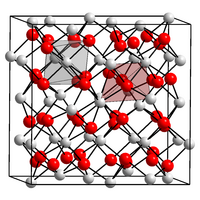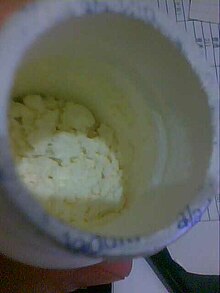Samarium (III) oxide
| Crystal structure | ||||||||||||||||
|---|---|---|---|---|---|---|---|---|---|---|---|---|---|---|---|---|

|
||||||||||||||||
| __ Sm 3+ __ O 2− | ||||||||||||||||
| General | ||||||||||||||||
| Surname | Samarium (III) oxide | |||||||||||||||
| other names |
|
|||||||||||||||
| Ratio formula | Sm 2 O 3 | |||||||||||||||
| Brief description |
odorless yellowish solid |
|||||||||||||||
| External identifiers / databases | ||||||||||||||||
|
||||||||||||||||
| properties | ||||||||||||||||
| Molar mass | 348.72 g mol −1 | |||||||||||||||
| Physical state |
firmly |
|||||||||||||||
| density |
8.347 g cm −3 |
|||||||||||||||
| Melting point |
2325 ° C |
|||||||||||||||
| solubility |
almost insoluble in water (20 ° C) |
|||||||||||||||
| safety instructions | ||||||||||||||||
|
||||||||||||||||
| Toxicological data | ||||||||||||||||
| As far as possible and customary, SI units are used. Unless otherwise noted, the data given apply to standard conditions . | ||||||||||||||||
Samarium (III) oxide is a chemical compound from the group of oxides .
history
Samarium (III) oxide was discovered in samarskite by Paul Émile Lecoq de Boisbaudran in 1879 .
Extraction and presentation
Samarium (III) oxide can be obtained by burning samarium in air.
It can also be obtained by thermal decomposition of samarium salts such as samarium oxalate or samarium carbonate at temperatures around 700 ° C.
Samarium (III) oxide nanoparticles can be obtained by reacting samarium hydride with oxygen .
A total of around 700 tons are produced each year.
properties
Samarium (III) oxide is an odorless, yellowish solid that is insoluble in water. It occurs in a monoclinic and a cubic crystal structure, with the cubic shape being more stable and common.
use
Samarium (III) oxide is used in infrared radiation absorbing glass. In organic chemistry, it catalyzes the reaction of acyclic primary alcohols to aldehydes and ketones . Another application is the production of other samarium salts such as samarium (III) sulfide .
Individual evidence
- ↑ a b c d e f g h data sheet samarium (III) oxide (PDF) from Merck , accessed on March 8, 2012.
- ^ Mary Eagleson: Concise encyclopedia chemistry , p. 583 ( limited preview in Google Book Search).
- ↑ Gerd Meyer, Lester R. Morss: Synthesis of lanthanide and actinide compounds . Springer Netherlands, 1990, ISBN 978-0-7923-1018-1 , pp. 196 ( limited preview in Google Book search).
- ↑ a b Eugene V. Dirote: trends in nanotechnology research . 2004, ISBN 1-59454-091-8 , pp. 114 ( limited preview in Google Book search).
- ^ John Emsley: Nature's building blocks: an AZ guide to the elements . Oxford University Press, 2003, ISBN 0-19-850340-7 , pp. 372 ( limited preview in Google Book search).
- ↑ Pradyot Patnaik: Handbook of Inorganic Chemistry . McGraw-Hill, 2002, ISBN 0-07-049439-8 .
- ↑ G. Meyer, Lester R. Morss (Ed.): Synthesis of Lanthanide and Actinide Compounds . Springer, 1991, ISBN 0-7923-1018-7 , pp. 328 ( limited preview in Google Book search).



